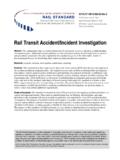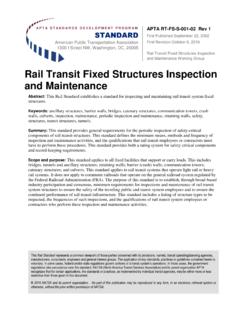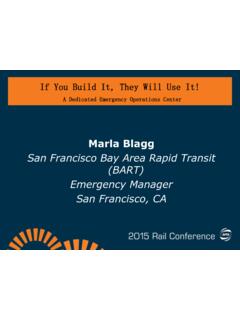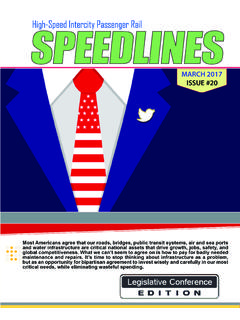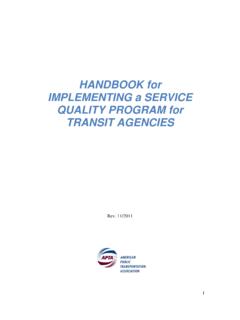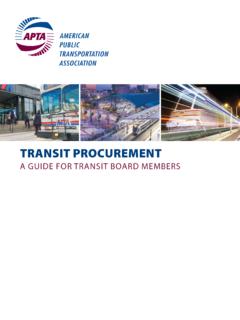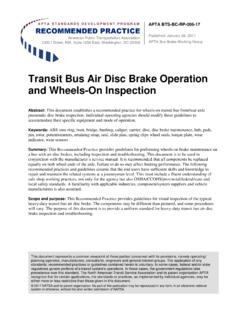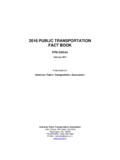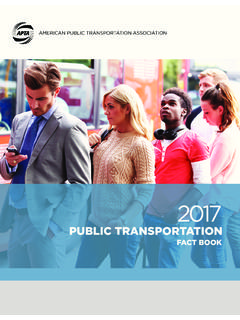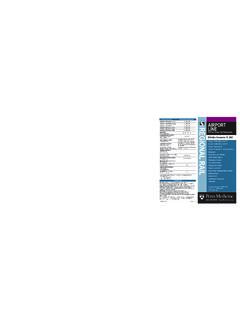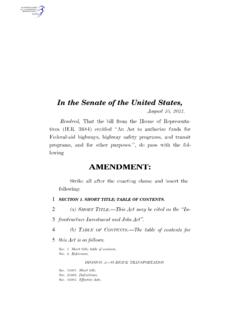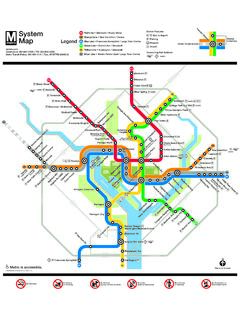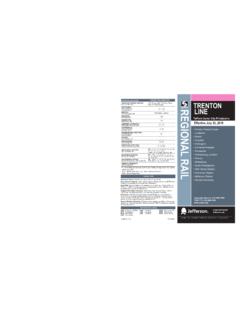Transcription of Rail Transit Track Inspection and Maintenance
1 A P T A S T A N D A R D S D E V E LO P M E N T P R O G R A M STANDARD American Public Transportation Association 1300 I Street, NW, Suite 1200 East, Washington, DC 20006 APTA RT-FS-S-002-02, Rev. 1 First Published: Sept. 22, 2002 First Revision: April 7, 2017 rail Transit Fixed Structures Inspection and Maintenance Working Group This document represents a common viewpoint of those parties concerned with its provisions, namely operating/ planning agencies, manufacturers, consultants, engineers and general interest groups. The application of any standards, recommended practices or guidelines contained herein is voluntary. In some cases, federal and/or state regulations govern portions of a Transit system s operations. In those cases, the government regulations take precedence over this standard. The North American Transit Service Association (NATSA) and its parent organization APTA recognize that for certain applications, the standards or practices, as implemented by individual agencies, may be either more or less restrictive than those given in this document.
2 2017 NATSA and its parent organization. No part of this publication may be reproduced in any form, in an electronic retrieval system or otherwise, without the prior written permission of NATSA. rail Transit Track Inspection and Maintenance Abstract: This standard provides minimum requirements for inspecting and maintaining rail Transit system tracks. Keywords: fixed structures, Inspection , Maintenance , qualifications, rail Transit system, structures, Track , training Summary: This document establishes a standard for the periodic Inspection and Maintenance of fixed structure rail Transit tracks. This includes periodic visual, electrical and mechanical inspections of components that affect safe and reliable operation. This standard also identifies the necessary qualifications for rail Transit system employees or contractors who perform periodic Inspection and Maintenance tasks. Scope and purpose: This standard applies to Transit systems and operating entities that own or operate rail Transit systems.
3 The purpose of this standard is to verify that tracks are operating safely and as designed through periodic Inspection and Maintenance , thereby increasing reliability and reducing the risk of hazards and failures. 2017 American Public Transportation Association | ii Table of Contents Participants .. v Introduction .. vi Note on alternate vi 1. Overview .. 1 Measuring Track not under load .. 1 Combination of conditions .. 1 Restoration and renewal of Track .. 1 2. Qualified persons .. 1 Designation of qualified persons .. 1 Work performed by 1 Minimum qualifications of qualified persons .. 1 3. Inspection .. 2 Track Inspection .. 2 rail Inspection .. 2 Continuous welded rail Inspection .. 2 Geometry Inspection .. 2 Detailed switch and crossing Inspection .. 3 Special Inspection .. 3 4. Condition reporting .. 3 Reporting of a condition s location .. 3 Classes of Track .. 3 Condition prioritization .. 4 5. Corrective action.
4 5 Required action .. 5 Conditions detected by automated Track Inspection vehicles .. 5 6. Roadbed .. 5 Drainage .. 5 Vegetation .. 6 Storage of materials and equipment along the right-of-way .. 6 7. Track appliances and devices .. 6 Lift. rails .. 6 Derails .. 6 Slip rails (expansion joints) .. 7 Switch heaters .. 7 rail lubrication .. 7 8. Track geometry .. 8 Track gage .. 8 Horizontal alignment (line) .. 8 Track surface .. 9 Superelevation .. 9 Superelevation runoff .. 9 Determination of superelevation .. 9 Horizontal curve data .. 10 2017 American Public Transportation Association | iii 9. Track structure .. 10 Ballast .. 10 rail fastener requirements .. 11 Clearances .. 13 10. rail .. 14 Defective rails .. 14 rail wear .. 20 rail joints and rail ends .. 20 Continuous welded rail (CWR) .. 22 11. Restraining (guard) rails on regular Track .. 25 Restraining rail guard face gage .. 25 Restraining rail Maintenance standards.
5 25 12. Special Track work .. 26 General 26 Switches .. 26 Frogs, general .. 27 Guardrail gages in frogs .. 28 Special work .. 28 13. Street-running Track work .. 28 Inspection .. 28 Roadbed .. 29 Track geometry .. 29 Track structure .. 29 rail .. 30 Special Track work .. 31 14. Elevated Track .. 32 Types of structures .. 32 Emergency protection rails (inner bridge guardrails) .. 32 Spacing, fastening and type of crossties in open-deck elevated structures .. 33 Walkways and handrails .. 34 rail expansion joints (slip rails) on elevated structures .. 35 Installation of CWR on elevated structures .. 35 References .. 36 Definitions .. 36 Abbreviations and acronyms .. 54 Summary of document changes .. 55 Document history .. 57 Appendix A (informational): Track surface table .. 58 Appendix B (informational): Continuous welded rail (CWR) recommended practices .. 59 Appendix C (informational): rail wear recommended practices .. 83 Appendix D (informational): Special Track work recommended practices.
6 84 2017 American Public Transportation Association | iv Appendix E (informational): Typical Track and switch Inspection forms .. 85 List of Figures and Tables Table 1 Classes of Track .. 4 Table 2 Condition Prioritization .. 4 Table 3 High-Water Conditions1 .. 5 Table 4 Track Gage Limits1 .. 8 Table 5 Maximum Allowable Horizontal Alignment Deviation .. 8 Table 6 Track Surface .. 9 Table 7 Ballast Guidelines for Concrete Ties .. 11 Table 8 Ballast Guidelines for Wood and Composite Ties .. 11 Table 9 Minimum Number of Non-Defective rail Fasteners for Any 39 ft. Length of rail .. 12 Table 10 Maximum Number of Consecutive Defective rail Fasteners Per 39 ft. Length of rail .. 12 Table 11a rail Defect Remedial Action .. 18 Table 11b rail Defect Remedial Action .. 19 Table 11c rail Defect Remedial 20 Table 12 rail End Mismatch .. 22 Table 13 rail End Batter .. 22 Table 14 Double Guarding Restraining Rails Guard Face Gage .. 25 Table 15 Guard Check and Guard Face Gages in Frogs.
7 28 Table 16 Embedded rail Defect Remedial 31 Table 17 Tongue and Mate Switch Conditions .. 32 Table A1 Maximum Allowable Speeds on Various Track Conditions .. 58 Table B1 Longitudinal rail Expansion vs. Temperature Change .. 60 Table B2 Longitudinal rail Forces vs. Temperature Change (in pounds) .. 61 Figure B1 Effects of Throws on Neutral Temperature, 100 ft. Long Curves .. 65 Figure B2 Example CWR Disturbance Report .. 79 Table B3 Change in rail Length .. Error! Bookmark not defined. Table B4 Desired rail Laying Temperature Ranges .. 82 Table C1 rail Wear Limits .. 83 2017 American Public Transportation Association | v Participants The American Public Transportation Association greatly appreciates the contributions of Antonio Cabrera, Austin Marshal, Bill Morehead, Al Panuska, Balaje Rachandran and Mark Rudnicki, who provided the primary effort in the drafting of this document. At the time this standard was completed, the rail Transit Standards Fixed Structures Inspection and Maintenance Working Group included the following members.
8 Greg O Hare, Chair Clay Bunting, Vice Chair Bong Vang, Secretary Carlton Allen Charles Anderson Andrew Baker Ray Blount John Burkhard Steve Brasfield Antonio Cabrera Rob Chappell Arthur Douwes Michael Esford Mark Evans Robert Fiore Brian Hooker Rich Hovde Travis Jones Rick Kindig Project Team Charles Joseph American Public Transportation Association Jeff King Joni Korte Austin Marshal Michael Monestero Bill Morehead Will Mullet Rotimi Ogunsuyi Phil Olekszyk Al Panuska Balaje Ravichandran Stephen Roberts Carol Rose Mark Rudnicki Dan Schiffer Glenn Shankle Frederick Smith Paul Swanson Steven Thompson Bong Vang Carrie Wagener This document represents a common viewpoint of those parties concerned with its provisions, namely operating/ planning agencies, manufacturers, consultants, engineers and general interest groups. The application of any standards, recommended practices or guidelines contained herein is voluntary.
9 In some cases, federal and/or state regulations govern portions of a Transit system s operations. In those cases, the government regulations take precedence over this standard. The North American Transit Service Association (NATSA) and its parent organization APTA recognize that for certain applications, the standards or practices, as implemented by individual agencies, may be either more or less restrictive than those given in this document. 2017 NATSA and its parent organization. No part of this publication may be reproduced in any form, in an electronic retrieval system or otherwise, without the prior written permission of NATSA. Introduction This introduction is not part of APTA RT-FS-S-002-02, Rev. 1 rail Transit Track Inspection and Maintenance . Sections 1 through 11 of this document describe the common Track elements used on all types of Track construction. Specific types of Track design and Track construction are described in Sections 12 through 14.
10 APTA rail Transit safety standards represent an industry consensus on safety practices for rail Transit systems (RTS) to help achieve a high level of safety for passengers, employees and the general public. This document was created by and for those parties concerned with its provisions, namely rail Transit systems (operating agencies), original equipment manufacturers (OEMs), consultants, engineers and general interest groups. This standard provides procedures for inspecting and maintaining rail Transit tracks. This standard intends to meet the following objectives: to ensure special life/safety equipment is operational and reliable to help rail Transit systems incorporate safety considerations during the Inspection and Maintenance process to identify Inspection criteria and Maintenance standards that provide a high level of passenger and personnel safety APTA recommends the use of this document by: individuals or organizations that operate rail Transit systems; individuals or organizations that contract with others for the operation of rail Transit systems; and individuals or organizations that influence how rail Transit systems are operated (including but not limited to consultants, designers and contractors).
